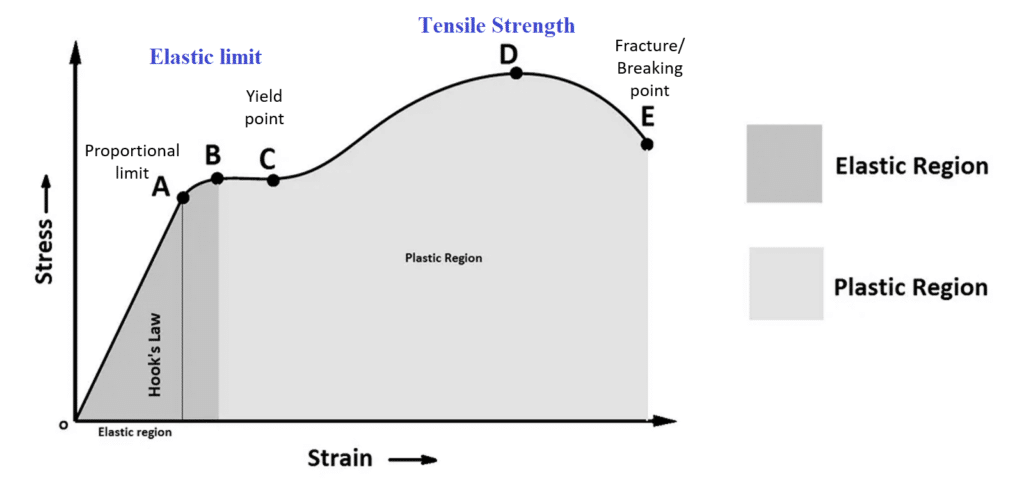Elastic modulus is a property of materials that tells us how stiff or resistant they are to be stretched or compressed when a force is applied. It is like a measure of how much a material will bend or change shape under stress. Materials with a high elastic modulus are harder to stretch or bend compared to materials with a low elastic modulus. The formula for elastic modulus (E) is:
E = stress/strain
where stress is the force applied per unit area of the material (measured in units such as pascals or pounds per square inch) and strain is the change in length of the material divided by its original length (measured in a unitless quantity such as meters per meter).

Table of Contents
Daily Life Examples of Elastic Modulus
Some examples of everyday materials and their elastic moduli:
- Rubber bands: Rubber bands have a low elastic modulus, which means they are easy to stretch and deform.
- Steel springs: Steel springs have a high elastic modulus, which means they are stiff and difficult to deform.
- Bicycle tires: Bicycle tires are made of rubber, which has a low elastic modulus, allowing them to compress and absorb shocks while riding.
- Concrete: Concrete has a relatively high elastic modulus, which makes it strong and resistant to deformation.
- Human bones: Human bones have a relatively high elastic modulus, which makes them strong and resistant to deformation, allowing them to support the weight of the body.
- Guitar strings: Guitar strings have a specific elastic modulus that allows them to vibrate at specific frequencies, producing different musical notes.
Elastic Modulus in Simple Terms
Elastic modulus is a property of solid materials that tells us how stiff they are. It measures how much a material will bend or change shape when a force is applied to it. Elastic modulus is calculated by dividing the force applied to the material (stress) by the amount it stretches or compresses (strain) while still returning to its original shape. Materials that are stiffer have a higher elastic modulus, meaning they are more resistant to deformation. For metals, this value usually falls between 45 and 407 gigapascals.
Why Elastic Modulus is Important?
- Material design: Elastic modulus is one of the key parameters used in the design of structures and products. By knowing the elastic modulus of a material, engineers can determine how much it will deform under load and design products that will withstand that deformation without breaking.
- Material selection: Elastic modulus is a critical factor in selecting materials for specific applications. Materials with higher elastic moduli are stiffer and stronger and are therefore better suited for applications where rigidity and strength are important.
- Predicting material behaviour: The elastic modulus can help predict how a material will behave under different conditions, such as temperature changes, stress, and strain. This information is important for designing products that can withstand different environmental conditions.
- Quality control: Measuring the elastic modulus is an important part of quality control in manufacturing. By testing the elastic modulus of materials, manufacturers can ensure that their products meet specific performance standards.
- Material testing and research: The elastic modulus is a fundamental property of materials that is studied in research and testing. Understanding the elastic modulus of different materials helps scientists and engineers develop new materials and technologies for various applications.
Elastic Modulus Calculations of Commonly Used Materials
| No. | Material | Stress (MPa) | Strain | Elastic Modulus (MPa) | Explanation of Elastic Modulus |
| 1. | Steel | 100 | 0.001 | 100,000 | Steel is a stiff material that requires a large amount of force to stretch or compress. |
| 2. | Aluminum | 60 | 0.002 | 30,000 | Aluminum is a relatively soft material compared to steel, meaning it is easier to deform. |
| 3. | Brass | 80 | 0.0015 | 53,333.33 | Brass is an alloy of copper and zinc and has a lower elastic modulus compared to steel or aluminium. This means that it is easier to deform, and requires less force to do so. |
| 4. | Rubber | 5 | 0.05 | 100 | Rubber is a highly flexible material that can be stretched or compressed easily. |
| 5. | Wood | 50 | 0.001 | 50,000 | Brass is an alloy of copper and zinc and has a lower elastic modulus compared to steel or aluminum. This means that it is easier to deform, and requires less force to do so. |
Different Types of Modulus
| No. | Modulus | Description | Formula | Variables | Unit | Examples |
| 1. | Young’s modulus (Elastic modulus) | Describes the ratio of stress to strain in a material when deformation is elastic. | E = σ/ε | E: elastic modulus, σ: stress, ε: strain | Pascal (Pa) or gigapascal (GPa) | Steel (E = 200 GPa) |
| 2. | Shear modulus (Modulus of rigidity) | Describes the ratio of shear stress to shear strain in a material. | G = τ/γ | G: shear modulus, τ: shear stress, γ: shear strain | Pascal (Pa) or gigapascal (GPa) | Steel (G = 77 GPa) |
| 3. | Bulk modulus (Compressibility modulus) | Describes the ratio of applied pressure to resulting volumetric strain in a material. | K = -V(ΔP/ΔV) | K: bulk modulus, V: volume, ΔP: change in pressure, ΔV: change in volume | Pascal (Pa) or gigapascal (GPa) | Steel (K = 170 GPa) |
| 4. | Torsional modulus (Modulus of elasticity in torsion) | Describes the ratio of torque to twist angle in a material. | G = (τ/R)/(θ/L) | G: torsional modulus, τ: torque, R: radius of the wire, θ: twist angle, L: length of the wire | Pascal (Pa) or gigapascal (GPa) | Steel (G = 77 GPa) |
More Links
Resilience: Examples from Physics and Everyday Life
Yield Point| Definition and Stress-Strain Relation
Strain Energy- Definition, Formula and Daily Life Examples
Compressive Stress – Definition, Formula, SI Unit, and FAQs
Tensile Stress – Definition, Formula, SI Unit, and FAQs
The Spring Constant & Spring Force Concept
Joke of the Day 🙂
Why did the mechanical engineer break up with the material scientist? Because he was tired of hearing about her obsession with elastic modulus!
- BCl3 Lewis Structure in four simple steps - November 1, 2023
- PH3 Lewis Structure in four simple steps - October 8, 2023
- PF3 Lewis structure in four simple steps - September 24, 2023



